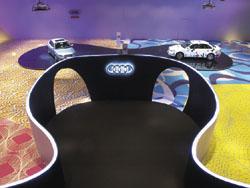Designer Forum - June 2008
Interview By Brian Hamilton
Award-winning New York industrial designer Karim Rashid has created everything from flooring to manhole covers and disposable cigarette lighters, as well as interiors for hotels, restaurants and other businesses. He believes in the concept of democratic design, which essentially means that high design should be widely available.
He freely acknowledges that the companies who hire him are taking a calculated risk. His distinctive and liberal use of bright colors and modern shapes will make some people wince and others crack a smile. Rashid, who’s developed award winning flooring for Tarkett Commercial’s Azrock solid vinyl tile line, as well as rugs for several overseas firms, says he’s never sure how his work will be received, and that’s just fine with him.
Rashid wants his work to reflect the here and now, and he says there’s no such thing as a timeless design. He’s partial to new technology and newer man-made materials that are relatively inexpensive and perform well. In his product design work he’s used plastics, foams and synthetic fabrics. In terms of flooring for his interior design work, he’s drawn to customized carpet, rugs, vinyl, some very specialized laminates, as well as concrete products that can be made any color. He’s also used materials like Alloy stainless steel mosaic tile in a hotel in Athens, Greece and in a restaurant in Singapore.
Rashid disdains wood as an anachronism, and not very durable. “I’d rather live in a place that’s about now, the day and age we live in, rather than pre-associations. I equate a wooden floor with a horse and buggy. All of our surfaces should have the equivalent progress.” He’d rather live in a world of microfiber suits because he can jam them in a suitcase, they won’t wrinkle, and they’ll still look good, unlike an expensive designer wool suit.
The world, he says, is a “bit too steeped in style and much less in real performance. Luxury today is more about high performance. There’s still a stigma with linoleum or vinyl, people don’t see them as luxury, they think it has to be travertine or marble. But I don’t buy it. These companies can redefine luxury.”
What makes Rashid’s work stand out as much as anything else is his use of vivid colors. In Rashid’s world, you can kiss earthtones goodbye. Skillful use of color, he says, is hard to learn and a designer either has it in his DNA or not. As a child he was heavily influenced by his father, an artist who sometimes used as many as 60 colors on a canvas. “Now I am my father,” he says.
Rashid makes the observation that the human eye can detect around 16,000 colors, so why not use more of them? Limiting the use of color is like eating just a few simple foods. “The majority of the world is quite gray,” Rashid says. “Why not have an orange building? Color has a power to it.”
Rashid believes that people, especially younger people, are generally more accepting of vivid colors because they’re used to dealing with them in the digital world.
In his interior design work, Rashid likes to get “pattern or ornamentation” on the floor. “I’m a little obsessed with that idea,” he says. In most designs, he says, the floor goes unnoticed, and in most projects there are more options for a well designed ceiling because the technology is available to create it. But he’s also found that it’s difficult to do with a lot of flooring because the available colors and patterns are too limiting. For example, in one gelateria in Las Vegas he wanted to use a solid pink floor. “Where can you get a solid pink floor? That boils down to one or two companies,” he says. He tracked one of them down. He likes to custom design visually stunning, over-the-top carpet for his restaurant projects when the budget will allow it. He also likes the sound deadening properties of carpet in general for restaurant work.
Despite the unusual colors, shapes and patterns he creates, every project starts with two overriding concerns—budget and performance. “You can do the most avant-garde work as long as it functions well,” Rashid says. “You can do beautiful work but if it doesn’t function it will be out of the market.”
Copyright 2008 Floor Focus
Related Topics:Tarkett
